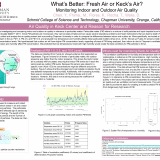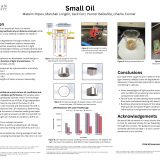
What’s Better, Fresh Air or Keck’s Air? Comparing Indoor and Outdoor Air Quality Yuki Chen, Mimi Fhima, Krystal Flores, Tommy Rocha, DJ Walia
May 11, 2020
Our team’s grand challenge is investigating and comparing indoor and outdoor air quality in reference to particulate matter. Since PM particles are microscopic, they can be easily inhaled and can cause severe respiratory problems and heart malfunctions that can lead to death. Consequently, we decided to collect and analyze the air quality present and surrounding Chapman University in order to compare the differences between indoor and outdoor air. More specifically, we looked at the three most common sizes of particulate matter present in the air, PM 1.0, PM 2.5, and PM 10.0, and analyzed how temperature and humidity affects these particulate matters. We hypothesized that outdoor air will have higher PM concentration levels, regarding all sizes of PM being analyzed, than indoor air due to Chapman’s ventilated buildings. We also tested how variables such as temperature and humidity affect PM concentration. We predicted that low temperatures mixed with high humidity would create the best conditions for PM particles to thrive.


